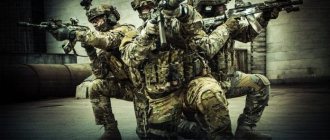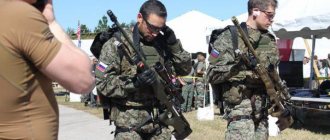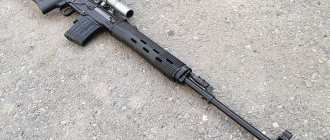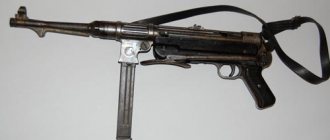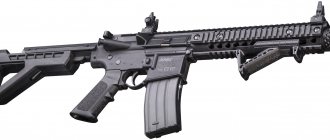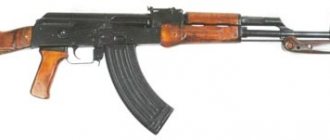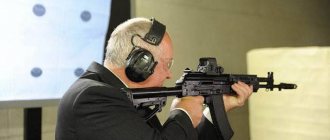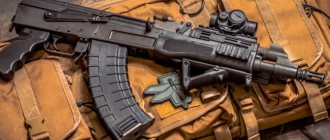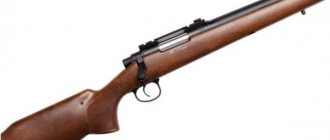So in this review we will compare the AS VAL from NPO AEG 2014 and the AS VAL from LCT with the combat AS VAL.
The SHAFT from LCT was provided by the Airsoft-Rus store.
The SHAFT from NPO AEG was provided for comparison directly by the manufacturer.
Naturally, we do not have access to the combat shaft, so we will compare using photographs from the kArden blog and information that is available on the Internet.
To begin with, we will compare the main ones, let’s call them “airsoft” characteristics of the drives, and then move on to comparison in terms of the degree of copyability in relation to the combat model.
Principle of operation
There are two principles of operation of the machines - electromechanical and gas cylinder. The electromechanical method uses the principle of spring-piston pneumatics driven by an electric motor. The piston is retracted back, simultaneously with the spring being charged, through a gear system (gearbox) connecting the pneumatic structure to the engine.
Advantages of electromechanical weapons:
- high rate of fire;
- no recoil or barrel drift to the side;
- Possibility of shooting at low temperatures.
Disadvantages of electromechanical machines:
- reducing the number of shots per charge at sub-zero temperatures;
- insufficient realism of the weapon's behavior when firing.
To ensure maximum ambiance of the machine guns, a gas-cylinder design is used, which allows simulating the real movement of the weapon when fired.
Gas guns for airsoft
The operating principle is based on the use of the energy of compressed gas contained in a cylinder. The use of liquefied carbon dioxide in weapons limited by “freezing” during the production of a series of shots has become widespread in more compact pistols.
A characteristic difference from electromechanics is the behavior of the structure when fired.
Due to gas pressure, the bolt group moves backward, which causes the barrel to move to the side and a characteristic clanging sound. This system is called “blowback”.
Advantages of gas machines:
- maximum imitation of the recoil effect;
- no need to recharge the battery.
Design disadvantages:
- you have to constantly carry a gas cylinder (up to 2 liters) with you, which makes the entire system more cumbersome;
- reduced weapon effectiveness at subzero temperatures.
Let's look at some of the most recognizable and best-selling airsoft machines that imitate legendary small arms. Their main characteristics are summarized in the table.
Review of the Kalashnikov Airsoft assault rifle
Kalashnikov assault rifle (AK-47) Airsoft for airsoft
The model is quite popular in the airsoft community, and many consider it the best. This is facilitated by the low price and sufficient efficiency when compared with more expensive and advanced models.
Equipment
The standard packaging includes a machine gun, a magazine, a cleaning rod and instructions. Depending on the supplier, the model may be equipped with a battery and charger.
Device and appearance
The assault rifle is a fairly similar copy of the AK-47 assault rifle. An open mechanical sight allows you to quickly fire at suddenly appearing targets.
The small weight, in comparison with the original, is not a sign of fragility - the model can withstand a fall to the floor from a height of more than one meter (with the butt attached).
Advantages and disadvantages
Advantages of the system:
- lower price than for other similar drives (5-7%);
- high similarity to the original;
- good repeatability of tactical and technical parameters in several samples.
Disadvantages of the machine:
- presence of slight play of parts at fastening points;
- the use of light alloys gives the weapon the feeling of a toy in the hands;
- bunker shop, which is not to the liking of many airsoft fans.
No noise and dust
By the 70s of the last century, a number of special-purpose units were created in the USSR. To carry out covert operations behind enemy lines, the “specialists” needed special weapons, including low-noise ones. The samples that existed at that time did not fully meet the requirements of the army, as well as other interested law enforcement agencies, so Soviet gunsmiths developed a whole range of new special-purpose weapons - “Val”, “Vintorez” and others.
The most problematic was the niche of low-noise long-barreled weapons, in which standard Kalashnikov assault rifles of various modifications were used. The reduction in shot noise was achieved through the installation of silencers with rubber seals and the use of a special US (reduced speed) cartridge. However, this reduced the accuracy and effective range of fire - especially taking into account the mass distribution of personal armor protection that had begun.
Kalashnikov assault rifle with PBS silencer (Silent Shooting Device)
Based on the results of a series of studies, it was decided to create a whole complex of new silent weapons for special forces: a pistol, a machine gun, a sniper rifle and a grenade launcher.
"Vintorez" and "Val"
Of the conflicting requirements put forward by various departments, by 1983, tactical and technical requirements were formulated only for a special sniper complex, work on which was carried out under the code “Vintorez”. This later became the unofficial name for the new silent rifle.
Vintorez was required to covertly defeat enemy personnel at a distance of up to 400 meters and penetrate a steel helmet at the same distance. Since reducing the noise of a shot could only be achieved by using a cartridge with a subsonic bullet speed, it was possible to maintain the required bullet energy at 400 meters only by increasing its mass. The first version of the cartridge was made in 7.62 mm caliber based on the cartridge case of a standard 5.45x39 mm machine gun cartridge.
Closest relatives: VSS “Vintorez” sniper rifle and AS “Val” special assault rifle (https://karden.livejournal.com)
However, by the end of 1985, the customer finally came up with demands for a special machine gun, which at the same 400 meters was required to penetrate not only a helmet, but also a bulletproof vest of class III protection. As a result, the cartridge caliber had to be increased to 9 mm. The new cartridge was developed in two versions: sniper SP-5 and armor-piercing SP-6. It was for them that the VSS (Special Sniper Rifle) was eventually released, and then the AS (Special Sniper Rifle), created on its basis, the “Val”, which had a folding metal butt instead of a permanent wooden one.
The automation of the new weapon worked on the principle of gas exhaust from the barrel with rigid locking by a rotating bolt. Actually, the barrel of the VSS and AC was made short, only 200 mm, with rows of holes drilled along the rifling in the muzzle to remove gases from the barrel bore into the expansion chamber of the muffler.
Although formal production of the VSS rifle began in 1987, even before the withdrawal of Soviet troops from Afghanistan, data on its combat use there have not yet been confirmed. Most sources agree that the first war for the new “no noise” was the conflict in Chechnya. At the same time, VSS and AS were used by both sides: some of the special “barrels” were given to the militants during the seizure of the local KGB armory, and some were simply bought.
Special cartridges 9×39 mm SP-5, SP-6, PAB-9
Most of the fighters who used the new special weapons spoke positively about them: the VSS and AS showed themselves to be excellent weapons for special units at short and medium distances. The following descriptions were quite typical:
“The AC/VSS weapon system is close to the ideal weapon for special forces. Its skillful use can work wonders. So, for example, during one of the close fire battles, a reconnaissance group from our unit managed to kill five people, including the lead patrol, before the opposing side began to understand something.”
Actually, one of the main drawbacks preventing the wider dissemination and use of the VSS was the technological complexity and, as a consequence, the high cost of the rifle. For example, the receiver of a weapon was made by milling.
Therefore, back in the early 90s, work began on creating a cheaper analogue. At the same time, the Ministry of Internal Affairs was especially interested in the potential of the new 9-mm cartridge. The Kalashnikov-based “short guns” used, due to their high penetrating power and tendency to ricochet, were quite dangerous for use in the city. In turn, hastily created new models of submachine guns chambered for the 9x18 Makarov cartridge could do little against body armor.
More in number, cheaper in price
This time, designers from Tula and Klimovsk acted as competitors. At TsNIITochmash, a new compact automatic machine was developed on the basis of the AS “Val”: it became the MA (Small Automatic) SR-3 “Whirlwind”. In general, it was still the same “Val”, only deprived of an integrated muffler, initially without even the possibility of installing a removable one: it was added only on the modernized version of the SR-3M. The result is a compact and powerful weapon, comparable in size to submachine guns, but noticeably superior to them due to its powerful cartridge.
A special forces soldier with a special small-sized machine gun 9A-91 https://karden.livejournal.com
However, in the “hungry” 90s, the work of the Tula people from the Instrument Design Bureau, who developed their new 9A-91 assault rifle for SP cartridges, and then the VSK-94 sniper rifle based on it, looked much more interesting. Although the Russian army and the Ministry of Internal Affairs continue to purchase systems from both developers, based on the results of operation, the balance is still more likely in favor of simpler, more reliable and cheaper products from the Tula KBP. Here is the opinion of one of the current officers of the Ministry of Internal Affairs of the Russian Federation:
“VSK, being cheaper, was purchased by the Ministry of Internal Affairs in much larger quantities than VSS. Both of them are in service, because at first the VSS were purchased, but due to the high cost and relative tenderness, the VSK-94 was included in the matter, which was proposed to replace the VSS. One of the decodings of the abbreviation VSK is “Military Sniper Complex”. With similar characteristics, it is cheaper and more reliable than VSS under difficult operating conditions. Most likely, price is the deciding factor. For greenhouse conditions, VSS is preferable. Accuracy should be no more than 7 cm (according to unverified data). VSK-94 allows careless care. Accuracy is allowed no more than 10 cm. Warranty firing rate for VSS is 5000 rounds, VSK-94 is 6000 rounds. If I need accuracy and noiselessness, I choose the VSS; if I want to be sure of reliability without long maintenance (intense combat operations, extreme weather and terrain), for self-defense (intense automatic fire, the ability to shoot without a silencer) - I choose the VSK-94.” .
Sniper rifle VSK-94 https://karden.livejournal.com
It should be noted that at the moment, both in the West and in the Russian Federation, a fairly significant part of the efforts to improve small arms is aimed at increasing the capabilities of the weapon by giving it as much “modularity” as possible and the ability for the fighter to configure it “for himself.” For example, in relation to small-sized assault rifles (“Vikhr” and 9A-91), the following wishes were expressed:
- lengthen the barrel (9A-91);
- make the butt retractable with a lock, like on the Kashtan submachine gun;
- make the PBS muffler dismountable;
- leave the rear sight similar to that used on the AKS assault rifle.
At the same time, unfortunately, the “domestic manufacturer” responded and is responding to the end customer’s requests much less quickly than private offices, and the latter’s capabilities in working with service weapons are often limited. As a result, weapons are modified using the “collective farm tuning” method: the necessary parts are purchased or ordered to craftsmen at the fighters’ own expense.
The author thanks OSN “Viking” (UFSIN of the Russian Federation for the Vologda Region) for the opportunity to find out the opinion of law enforcement officers about the weapons used.
M1A1 Thompson
M1A1 Thompson assault rifle for airsoft
The model is a copy of a famous machine gun from the time of the gangster wars in the USA in the 30s. Initially, the model was a submachine gun, but its impressive dimensions are consistent with modern machine guns.
Equipment
The French brand cares about maintaining its own image, so the equipment of the machine includes everything that is necessary for full use. It includes instructions, a magazine, a cleaning rod for cleaning the barrel, a battery and a charger.
Device and appearance
The machine gun has a solid wooden butt and a separate safety and fire selector. Unlike other models of the Thompson assault rifle, this sample does not have a disk magazine. The airsoft M1A1 Thompson became especially popular during the reconstruction of the events of the Prohibition era.
The other side of the game is airsoft sniper rifles. Unlike a dynamic game with a slot machine, this requires endurance and concentration. This article reviews several models of sniper rifles. All about the SVD air rifle of 4.5mm caliber and higher can be read here. Features of using this weapon.
Advantages and disadvantages
Advantages of the model:
- high similarity to the original, which helps to “plunge” into a bygone era;
- high rate of fire;
- High-quality wooden parts are pleasant to hold in your hands.
Design disadvantages:
- bulkiness;
- small magazine capacity;
- insufficient accuracy at long distances.
AS "Val" for airsoft
AS Val assault rifle for airsoft
The model is an imitation of the famous Russian “sniper machine gun”. As with the original, this Airsoft model is preferred for use in assault teams and sniper groups.
Equipment
The basic equipment of the machine is not very diverse. In the standard version, it only includes a magazine and user instructions. You have to purchase the battery and charger yourself.
Device and appearance
The model has a folding metal stock and a false silencer. The main barrel is placed inside a guide tube, which increases rigidity and prevents loosening of the structure.
The appearance, configuration and shooting from the AS “VAL” pneumatic airsoft machine can be seen in the video:
Advantages and disadvantages
Advantages of the model:
- the machine gun is a very similar copy of a military weapon;
- The gearbox is easily modified (in a workshop).
Design disadvantages:
- sometimes the fire switch sticks;
- with intensive use, the coating of the weapon quickly wears out;
- individual structural elements spoil the impression of the model (the butt is secured with low-quality rivets, the attachment points are too massive, etc.).
Conclusions. Which is better AS VAL from NPO AEG or AS VAL from LCT?
As you can see for yourself, both models are generally different from the original. The point is mainly in the dimensions of the receiver in which the gearbox has to be placed and in small details, which are most likely expensive for manufacturers to copy.
Visually, the model from NPO looks more similar to the original, but if you look closely at the details, the differences are noticeable. The model from LCT is made with traditional quality, but it looks simpler.
The internals of the drive are very similar, with the exception of the barrel. Is it worth paying almost 10,000 rubles for greater visual similarity? It’s up to YOU to decide. We invite you to draw your own conclusions and share them in the comments.
Model specifications
| № | AK-47 Airsoft | M1A1 Thompson | AS "Val" | |
| 1 | Caliber (mm) | 6 | 6 | 6 |
| 2 | Bullet speed (m/s) | 110-120 | 100 | 120 |
| 3 | Magazine capacity, pcs. | 500 | 47 | 50 |
| 4 | Weight (kg) | 2.8 | 2.9 | 4.2 |
| 5 | Length (mm) | 830 | 805 | 875 |
| 6 | Energy source | battery | battery | battery |
| 7 | Bullet type | plastic balls | plastic balls | plastic balls |
| 8 | Material | wood (handle, butt and fore-end), metal parts made of silumin | wood and zinc alloy | forend and handle made of plastic, other parts (including butt) made of steel |
| 9 | Power | 1 J | 1 J | 1 J |
| 10 | Barrel type | smooth, silumin | smooth, zinc alloy | smooth, steel |
| 11 | Fuse type | non-automatic | non-automatic | non-automatic |
| 12 | Sights | open | open | open |
| 13 | Possibility of installing third-party sighting devices | only after tuning | only after tuning | present initially |
| 14 | Manufacturer | CYMA (China) | Cybergun (French brand, production facilities in Hong Kong) | LCT (Taiwan) |
| 15 | price, rub. | 5800-6200 | 11500-12500 | 16000-17000 |
Comparative table of “airsoft characteristics” of AS VAL LCT 2014 and AS VAL NPO AEG 2014:
| Characteristic | LCT | NPO-AEG |
| Year of issue | 2014 | 2014 |
| Gearbox | LCT 3 versions | LCT 3 versions |
| Price | 17 000 — 19 000 | 26 000 — 30 000 |
| Cost of stores | 490 | ~900 |
| Magazine capacity | 50 balls | 50 balls |
| Store compatibility | Suitable for peeling | Unsuitable |
| Wiring and connector | Mini Tamiya, hard | tough, there is a T-connector right away |
| Inner stem | 6.02 mm steel, produced by NPO AEG | 6.02mm brass, produced by LCT |
| Inner barrel catcher in muffler | No | There is |
Let's move on to comparison from the point of view of copyability. We tried to approach this issue with special passion, of course, due to our capabilities and due to the availability of information.
